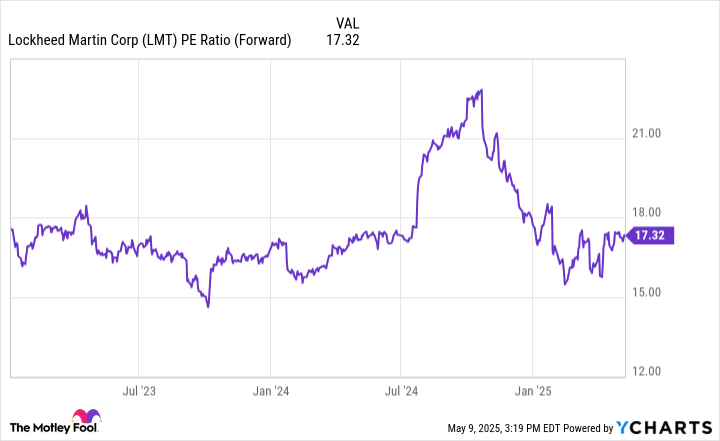In times of market volatility, investors search for stability in their portfolios. Defense stocks can serve this need. If you are tired of watching high-growth stocks go up and down wildly and add stress to your life, you may want to transition some of your invested capital to defense-industry stocks that generate steadier returns with less volatility.
Lockheed Martin (LMT -2.71%) is the perfect defense stock for you to buy right now. It has steady contracts with the U.S. and its allies around the world, and its stock is currently in a 23% drawdown. The stock market may be worried about potential lost contracts from European countries, and the stock has fallen with the broad market, but this is missing the forest for the trees.
Here’s why investors can buy shares of Lockheed Martin and hold them forever.
Rock-solid defense contracts
As one of the largest players in the defense sector, the company has a sprawling operation that’s diversified across both aerospace and defense. It has F-35 contracts totaling in the hundreds of billions of dollars for countries across the globe, as well as missiles, rotary and mission systems, and space segments.
Last quarter, each of these four segments generated at least $379 million in operating profit, combining for $2.085 billion in profit in the quarter. The company is highly diversified across the defense sector, which should help it grow no matter what products are needed by countries at the moment.
Defense spending across the globe is beginning to grow again, mainly due to increased budgets in Europe and Asia. European countries will be using plenty of Lockheed Martin products and services. And while China is not going to look to a U.S. supplier for its defense needs, countries such as Japan and India are increasing defense spending as conflicts simmer around the world.
All this is to say that the company’s backlog keeps rising, hitting $173 billion last quarter. This is two years’ worth of revenue and shows the steady business that comes with signing long-term contracts with a country’s defense department.
A fighter jet taking off.
Consistent return of cash to shareholders
What makes Lockheed Martin a durable stock is not just its long-term contracts but management’s consistent return of cash to shareholders in the form of dividends and share repurchases.
In the last 10 years, the dividend per share is up 121% with linear growth in dividend payouts every year. Its shares outstanding are down around 25% due to aggressive buybacks, which has helped boost earnings per share (EPS) by over 100% in this time period.
Over the next 10 to 20 years, due to increased spending on defense, investors should see steady growth in the dividend per share along with rising earnings that can get funneled into share repurchases. These capital returns to shareholders should help boost the stock’s total return over the next decade and beyond.
LMT PE Ratio (Forward) data by YCharts.
A stock that trades at a reasonable price
Unlike many of the hypergrowth stocks out there, Lockheed Martin trades at a reasonable price-to-earnings ratio (P/E) after its 23% share price drawdown. It has a forward P/E of 17.
Projections for earnings growth can be more reliable for a stock like this one due to how durable its government contracts are. If you have the F-35 in your arsenal, it is close to impossible to skip spending on maintenance and services from Lockheed Martin for this fleet every year.
A reasonable looking forward P/E makes the stock even more attractive for long-term investors. The dividend is currently yielding 2.78%, a figure I believe can double over the next 10 years based on the current stock price. Share buybacks become more attractive the lower the stock price falls, which is a good thing for long-term shareholders.
Add everything together, and Lockheed Martin looks like a rock-solid stock to buy and hold over the long haul. Don’t be afraid to add it amid major stock market volatility.





